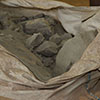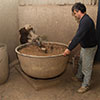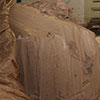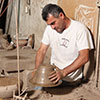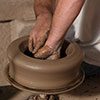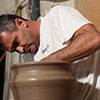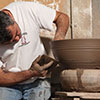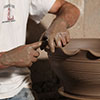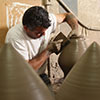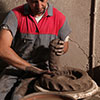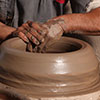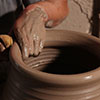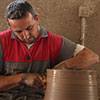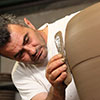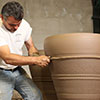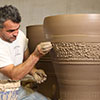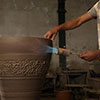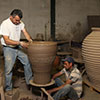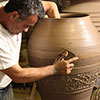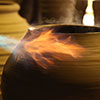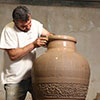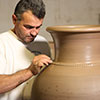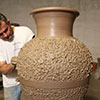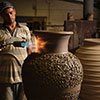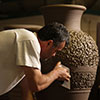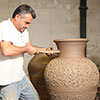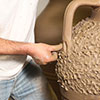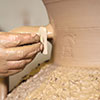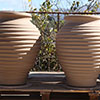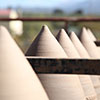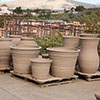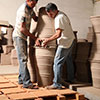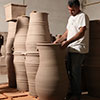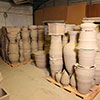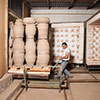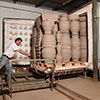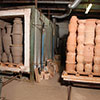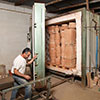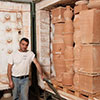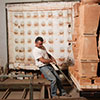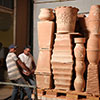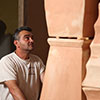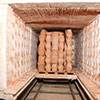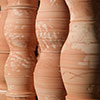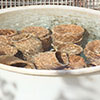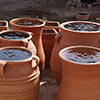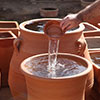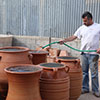Creating
Earth, water, fire. The three elements of nature when used properly give a perfect score. Ceramics of Thrapsano! Prerequisite of course, the hands and the art of a good Thrapsano potter.
Soil
The first basic material is suitable soil, rich in clay, known as pitharochoma. Found in large quantities in areas near Thrapsano and generally in Crete. During summer we move it into our specially designed space in order to be "screened", to distinguish it from foreign objects, wood, stones, garbage, etc. Then packaged in especially large sacks and stored in our warehouse to work throughout the season until next summer. This whole process, extremely difficult, done by ourselves so that we are confident for the quality of the soil we will work with.
Water
In a special machine, the "mixer", we mix thoroughly the soil with the water in the right proportion until we make the mud and then the "lumps" are ready for the potter to start create.
In the electric wheel we made small ceramics up to 30cm. The potter places the mud in the center of the wheel and with both hands gives the appropriate moves in the mud in order to shape the ceramic that he wants to make. The wheel is electric and with his foot increases or decreases the speed that moves the wheel and he places it on special wooden planks until dry and cooked.
The "wheel" made ceramics from 30cm up to 70cm. This wheel is Pedal, ie the potter turns it with his foot and gives the speed he wants. Above the wheel is placed a special plate (wooden) and on it will place the mud to work and build the ceramic he wants. Each ceramic is made piece by piece. At the beginning he makes the bottom of the first part of the ceramic (planting) which will take of the wheel plate and leave it outdoors under the sun or near a fire during the winter so as to "pull" ie dry a little. During this process, the potter makes as much ceramics (plantation) wants and can finish during the day. After it has dried out a little bit, the potter continues with the second piece over the first piece. He stuck with his hands the next piece of mud (stomosia) to continue the ceramic. The potter has various tools during the process such as sponge, especially pieces of wood etc. The same procedure is followed until all the ceramics are finished.
In the "track" are made very large ceramics from 70cm up to 170cm height. There we need 2 people, the craftsman who makes in the wheel the ceramics you want and "trocharis", ie the assistant of the craftsman that turns the wheel with his hands. We pour over the wheel small amount of pitharochoma in order to easily dislodge the ceramic when finished. Afterwards he places mud in the center of the wheel and makes the bottom of the ceramic and then the first part of this. In the same way he makes the first part of the ceramic that he wants and can finish in one or two days if necessary. Because these wheels are not placed on plates but the ceramics are made directly on the wheel they cannot be moved elsewhere to dry a little and continue with the next piece. In order to dry them we are using the "torch". After he finishes all the ceramics he waits until they get dry and well cooked.
Fire
With respect to our distinguished tradition of our ancestors, but having our eyes on the future and modern technology we are trying to combine and achieve the best possible result. For this reason we replaced the old kiln with new modern gas furnace. The old kiln inferior to uneven color that gives to the ceramics (other signs are white and others black - burnt) because the temperature is not the same at all points of the furnace, as well as the strength of ceramics at low temperatures. The ceramic in the modern furnace gas fired all uniformly from the smallest up to the largest object, so all have the same uniform color the color of the baked clay. Yet because of the very high temperature of the furnace, it makes ceramics very durable and inalterable in time.
Inside the ceramic kiln will remain for at least 13 hours with temperatures reaching up to 1080 degrees Celsius gradually.
Next day at noon we open the door of the furnace slowly, because the sudden change of temperature may break some ceramics.
Late in the afternoon we take out of the furnace the ceramics to our yard to completely get cool.
Next morning we fill with water the large ceramics and the small one will be placed in special tanks filled with water. This process is called "quenching" of ceramics and they become even more durable and compact.
Once dry we "paint" all ceramics with special colorless water repellent which makes them waterproof and durable in all temperature changes. After that will be drilled for water drainage in those planted and placed in the courtyard of our factory ready for sale.
Once we do all the processes right from the first to the last, our ceramics are ready to decorate your homes and gardens with the quality guarantee of Antonis Araviakis with years of experience in the art of ceramics and in the ceramics market in Greece and all over the world.





